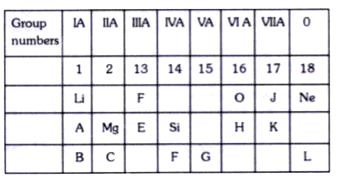Complete Solutions to Questions from Previous ICSE Board Papers (2009) of chapter PERIODIC PROPERTIES AND VARIATIONS OF PROPERTIES (PHYSICAL AND CHEMICAL) of Class 10 book with complete answers and questions
| Class 10 | CHEMISTRY |
| Chapter | PERIODIC PROPERTIES AND VARIATIONS OF PROPERTIES (PHYSICAL AND CHEMICAL) |
| EVERGREEN PUBLICATION | Questions from Previous ICSE Board Papers (2009) |
| Number Of Questions | 7 |
| Academic Year | 2023-24 |
Among Period-2 elements - Lithium, Carbon, Fluorine, Neon-State the one which has high electron affinity.
02:28View SolutionConsider the section of the periodic table given below.

Note : In this table B does not represent boron
C does not represent carbon
F does not represent fluorine
H does not represent hydrogen
K does not represent potassium
You must see the position of the element in the periodic table.
Some elements are given in their own symbol and position in the periodic table, while others are shown with a letter. With reference to the table:
Which is the most electronegative ?05:32View SolutionConsider the section of the periodic table given below.

Note : In this table B does not represent boron
C does not represent carbon
F does not represent fluorine
H does not represent hydrogen
K does not represent potassium
You must see the position of the element in the periodic table.
Some elements are given in their own symbol and position in the periodic table, while others are shown with a letter. With reference to the table:
How many valence electrons are present in G?02:27View SolutionConsider the section of the periodic table given below.

Note : In this table B does not represent boron
C does not represent carbon
F does not represent fluorine
H does not represent hydrogen
K does not represent potassium
You must see the position of the element in the periodic table.
Some elements are given in their own symbol and position in the periodic table, while others are shown with a letter. With reference to the table:
Write the formula of the compound between B and H.01:58View SolutionConsider the section of the periodic table given below.

Note : In this table B does not represent boron
C does not represent carbon
F does not represent fluorine
H does not represent hydrogen
K does not represent potassium
You must see the position of the element in the periodic table.
Some elements are given in their own symbol and position in the periodic table, while others are shown with a letter. With reference to the table:
In the compound between F and J, what type of bond will be formed ?02:29View SolutionConsider the section of the periodic table given below.

Note : In this table B does not represent boron
C does not represent carbon
F does not represent fluorine
H does not represent hydrogen
K does not represent potassium
You must see the position of the element in the periodic table.
Some elements are given in their own symbol and position in the periodic table, while others are shown with a letter. With reference to the table:
Draw the electron dot structure for the compound formed between C and K.06:22View SolutionDefine the following term : lonization potential.
01:24View Solution
Questions from Previous ICSE Board Papers (2009) questions and complete solutions for chapter PERIODIC PROPERTIES AND VARIATIONS OF PROPERTIES (PHYSICAL AND CHEMICAL) of EVERGREEN CHEMISTRY (ENGLISH) of Class 10
All Exercises from EVERGREEN PUBLICATION Class 10 CHEMISTRY PERIODIC PROPERTIES AND VARIATIONS OF PROPERTIES (PHYSICAL AND CHEMICAL)
- Additional Questions for Practice (ARRANGE THE FOLLOWING ELEMENTS AS INDICATED IN BRACKETS)
- Additional Questions for Practice (FILL IN THE BLANKS WITH THE SUITABLE WORDIS IN EACH CASE)
- Additional Questions for Practice (GIVE REASON FOR THE FOLLOWING)
- Additional Questions for Practice (SHORT ANSWER QUESTIONS)
- Additional Questions for Practice (VERY SHORT ANSWER QUESTIONS)
- Questions
- Questions from Previous ICSE Board Papers (2005)
- Questions from Previous ICSE Board Papers (2006)
- Questions from Previous ICSE Board Papers (2007)
- Questions from Previous ICSE Board Papers (2008)
- Questions from Previous ICSE Board Papers (2009)
- Questions from Previous ICSE Board Papers (2010)
- Questions from Previous ICSE Board Papers (2011)
- Questions from Previous ICSE Board Papers (2012)
- Questions from Previous ICSE Board Papers (2013)
- Questions from Previous ICSE Board Papers (2014)
- Questions from Previous ICSE Board Papers (2015)
- Questions from Previous ICSE Board Papers (2016)
- Questions from Previous ICSE Board Papers (2017)
- Questions from Previous ICSE Board Papers (2018)
- WORKSHEET-1 (Fill in the blanks with suitable words)
- WORKSHEET-1 (Give one word for the following)
- WORKSHEET-1 (Write short answer for the following)
- WORKSHEET-2
- WORKSHEET-2 (Fill in the blanks with suitable words)
- WORKSHEET-3
- WORKSHEET-3 (Fill in the blanks with suitable words)
- WORKSHEET-3 (Tick the correct options)
